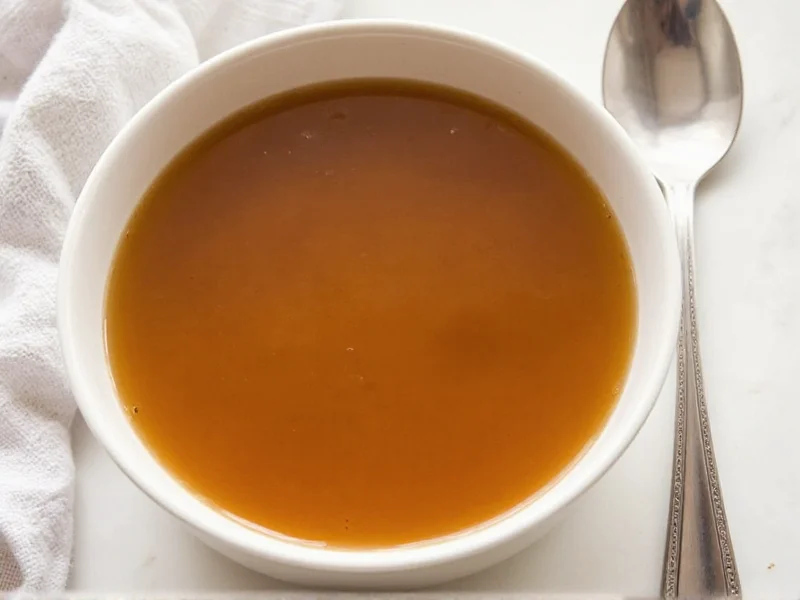The Science Behind Exceptional Beef Bone Broth
Creating superior beef bone broth isn't just about boiling bones—it's a careful extraction process. The extended simmering time (minimum 12 hours, ideally 18-24) breaks down collagen into gelatin while releasing valuable minerals from the bones. The addition of acidic ingredients like apple cider vinegar helps demineralize bones, increasing calcium, magnesium, and phosphorus content in your final broth.
Professional chefs and home cooks agree that bone selection makes or breaks your broth. Marrow bones provide richness, knuckle bones deliver collagen, and oxtail adds deep flavor complexity. Avoid pre-roasted bones from grocery stores, as they often contain additives that affect flavor and clarity.
Essential Ingredients for Authentic Beef Bone Broth
Quality ingredients transform basic broth into a culinary foundation. Here's what you need for the best homemade beef bone broth soup recipe:
| Ingredient | Quantity | Purpose |
|---|---|---|
| Beef marrow bones | 2-3 pounds | Rich flavor and fat content |
| Beef knuckle bones | 2-3 pounds | Maximum collagen extraction |
| Oxtail pieces | 1-2 pounds | Deep umami flavor |
| Apple cider vinegar | 2 tablespoons | Mineral extraction aid |
| Filtered water | Enough to cover bones | Clean base for extraction |
Step-by-Step Preparation Guide
Follow these professional techniques for restaurant-quality beef bone broth at home:
- Prep bones: Roast bones at 400°F for 30-40 minutes until deeply browned (optional but recommended for richer flavor)
- Initial soak: Cover bones with cold water and 2 tablespoons vinegar, let sit 30 minutes before heating
- First simmer: Bring to gentle boil, then immediately reduce to bare simmer (small bubbles barely breaking surface)
- Skim impurities: Remove foam during first hour of cooking for crystal-clear broth
- Add aromatics: After 2 hours, add onion, celery, carrot, garlic, and herbs
- Extended cooking: Maintain gentle simmer for 18-24 hours (use slow cooker or low oven for safety)
- Final strain: Pass through fine-mesh sieve, then cheesecloth for professional clarity
Pro Tips for Perfect Beef Bone Broth Every Time
Master these techniques to elevate your homemade beef bone broth soup recipe:
- Temperature control: Never let broth reach a rolling boil—this makes it cloudy and bitter. Maintain 180-190°F (82-88°C)
- Water level: Top up with hot water as needed to keep bones submerged, but avoid diluting flavor
- Layering flavors: Add different bones at different times—marrow bones first, then oxtail after 6 hours
- Gel test: Properly made broth should solidify when chilled—a sign of high collagen content
- Salt timing: Add salt only during final hour to prevent over-extraction of bitter compounds
Troubleshooting Common Bone Broth Issues
Even experienced cooks encounter challenges with beef bone broth preparation. Here's how to solve frequent problems:
- Cloudy broth: Caused by boiling too vigorously. Solution: Start with cold water, maintain gentle simmer, and strain through cheesecloth
- Weak flavor: Insufficient cooking time or poor bone selection. Solution: Use 50% knuckle bones, cook minimum 18 hours
- Bitter taste: Overcooked vegetables or bones boiled too hard. Solution: Add aromatics after first 2 hours, maintain low temperature
- No gel: Not enough collagen-rich bones. Solution: Include 30% knuckle bones and oxtail in your bone mix
- Fat separation: Normal occurrence. Solution: Chill completely, then remove solidified fat layer before reheating
Storage and Culinary Applications
Your finished beef bone broth has multiple uses beyond sipping. Proper storage maintains quality:
- Refrigeration: Store in airtight containers for up to 5 days
- Freezing: Pour into ice cube trays, then transfer to freezer bags for portioned use (keeps 6 months)
- Reduction: Simmer to create concentrated glace de viande for intense flavor in sauces
Use your homemade beef bone broth in traditional French consommé, hearty beef barley soup, or as the base for Asian pho. The collagen-rich liquid improves texture in braised dishes and adds nutritional value to grain pilafs. Many health-conscious cooks drink 4-6 ounces daily for joint health support.
Customizing Your Beef Bone Broth Recipe
Once you've mastered the basic technique for how to make beef bone broth from scratch, experiment with these variations:
- Asian-inspired: Add ginger, star anise, and scallions during final hour
- Herb-infused: Bundle thyme, rosemary, and bay leaves in cheesecloth for easy removal
- Spicy version: Include dried chilies or fresh jalapeños for Mexican-style consommé
- Quick method: Pressure cooker reduces time to 3-4 hours (use 25% less water)
Frequently Asked Questions
How long should I simmer beef bones for optimal broth?
For maximum collagen extraction and flavor development, simmer beef bones for 18-24 hours. Shorter times (12 hours) work but yield less gelatinous broth. Pressure cooking reduces this to 3-4 hours while maintaining quality.
What's the best combination of beef bones for broth?
The ideal mix includes 40% marrow bones for richness, 40% knuckle bones for collagen, and 20% oxtail for deep flavor. Avoid using only marrow bones as they create overly fatty, less structured broth.
Why does my beef bone broth not gel when chilled?
Lack of gelling indicates insufficient collagen extraction. This happens when using too few collagen-rich bones (knuckles, feet, oxtail), cooking for too short a time, or using bones that were previously cooked. Increase knuckle bone percentage and extend cooking time to 24 hours.
Can I use leftover roast beef bones for broth?
Yes, but expect weaker flavor and less gelatinous results. Previously roasted bones have already released much of their collagen and minerals. Boost quality by adding fresh knuckle bones and extending cooking time. Avoid bones with excessive char or burnt bits.











 浙公网安备
33010002000092号
浙公网安备
33010002000092号 浙B2-20120091-4
浙B2-20120091-4